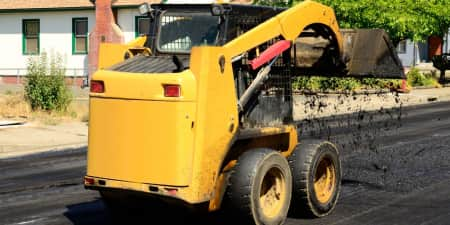Radial Lift vs Vertical Lift: Picking the Right Skid Steer
Skid steers have been around for more than 60 years and since then, they have been continuously innovated for increased performance. One of the most significant changes has been the evolution from having just radial lift skid steers to vertical lift loaders as well. But have you ever wondered what is the difference between radial and vertical lift skid steers? If so, we've got you covered.
Both skid steers and compact track loaders have radial and vertical lift capacities. These lifting styles have a direct impact on what construction projects they are best suited to work on. In this blog, we'll cover the types of skid lift styles, why it matters, the pros and cons of each, and what skid loaders have vertical lift functionality.
At the end of the day, both radial and vertical lift loaders can perform the same tasks but have different levels of efficiency.
Radial Lift
Radial lift loaders are the traditional style of skid steers. With their simple setup, these machines have a single pivot point for lifting the boom. If you can visualize it, the radial lift arm designs follow a C-like curve when being lifted. This means that they have the furthest reach when the boom is in front of the operator, and the shortest reach when the bucket is at the bottom or top of its arch.
Fundamentally, this makes them great for digging projects or when working at eye level. The best jobs for radial lift skid steers and compact track loaders include:
-
Earthmoving or material handling when working at or below eye level
-
Backfilling, unloading flatbed trucks, like sod deliveries, or when dumping materials over a low wall
-
Flatwork projects where more pushing is needed
-
Projects where forward reach is more necessary than height reach
- Great for excavating and grading projects
Radial Lift Loader Pros and Cons
Pros
-
Great visibility because there are fewer mechanics on the boom to interfere with your sight
-
Lift capacity and reach are best at the mid-height level of the machine, making them better suited for some jobs than vertical lift machines
-
Cheaper and easier to maintain because of the less complex mechanics. This means fewer things will go wrong with the machine
Cons
-
The load isn't always kept close to the machine which limits the stability of the machine
-
Lower lift capacity making them more of a small or medium-sized project machine. They are not as well suited for heavier-duty jobs
-
Because of the curve-like arm movement, dumping at max height is almost impossible without spilling into the cab or back onto the loader
Vertical Lift
Vertical lift loaders are becoming more preferred as lift capacity and strength, as well as vertical reach, are more desired specs. Instead of following a C-like curve path, these machines have a better ability to lift upwards on a consistently straight path. This is because of the intricate design of the boom which allows them to hinge in different areas.
Whereas radial skid steers move the load away from the machine at the midway point, vertical lift loaders keep the load closer to the machine through the entire lift path. In general, vertical lift machines can lift more weight than their opponents, making them great for large-scale projects.
Because of the height capacity and more enhanced dumping capabilities, vertical lift skid steer loaders are well-suited for projects like:
-
Loading or unloading dump trucks, hoppers, or high surfaces
-
Lifting and stacking materials because you'll be able to see the load better
-
Material handling when working at large heights
Vertical Lift Loader Pros and Cons
Pros
-
Can reach a maximum lift height without a drop in performance
-
They can lift higher than radial machines and at more capacity
-
Improved stability because the load will be more balanced throughout the lift path
-
Reach throughout the lift is fairly consistent
Cons
-
More hinge and lubrication points mean they're more expensive and harder to maintain
-
Limited visibility due to there being more parts to the boom to affect vision
Vertical Lift Skid Steers and Compact Track Loaders
If you're looking specifically to rent or buy a vertical loader, here is a list of the different makes and models:
Skid Steers
-
Bobcat S66
-
Bobcat S76
-
Cat 262D3
-
Cat 272D3
-
John Deere 318G
-
John Deere 320G
-
John Deere 324G
-
John Deere 330G
-
John Deere 332G
-
CASE SV185B
- CASE SV280B
-
CASE SV340B
-
GEHL V270
-
GEHL V330
-
GEHL V420
-
Kubota SSV65
-
Kubota SSV75
-
Manitou 2700V
-
Manitou 3300V
-
Manitou 4200V
-
ASV VS-75
Compact Track Loaders
-
ASV VT70
-
Bobcat T66
-
Bobcat T76
-
Cat 259D3
-
Cat 289D3
-
CASE TV370B
-
CASE TV450B
-
GEHL VT320
-
John Deere 317G
-
John Deere 325G
-
John Deere 331G
-
John Deere 333G
-
Kubota SVL75-3
-
Manitou 3200 VT
-
Takeuchi 10V2
-
Takeuchi 12V2
Read our in-depth skid steer spec guide and our skid steer and compact track loader brand comparisons.
Here's a simple guideline to help you decide which type of machine you need: For any job at or below eye level, use a radial lift machine. For anything over eye level, it's best to use a vertical lift skid steer. However, some equipment operators may also have a preference, so make sure to ask if that's the case.

